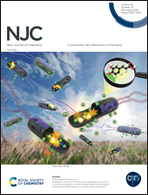Single Au@MnO2 nanoparticle imaging for sensitive glucose detection based on H2O2-mediated etching of the MnO2 layer†
Abstract
A dark-field microscopy (DFM)-based single nanoparticle color imaging method has been developed for the quantitation of glucose based on the enzymatic reaction of glucose oxidase (GOx) and the unusual reaction that H2O2 etches the MnO2 layer on Au@MnO2 nanoparticles. In the presence of GOx and oxygen, glucose is converted to gluconic acid and hydrogen peroxide (H2O2) that etches the MnO2 layer on Au@MnO2 nanoparticles. As a result, the localized surface plasmon resonance (LSPR) property of the nanoparticles could be tailored depending on the glucose concentration. Having high spatial and temporal resolution, the DFM approach allows monitoring of the change in the scattering intensity and color of single Au@MnO2 nanoparticles induced by H2O2. The color of single Au@MnO2 nanoparticles undergoes a noticeable change from orange to yellow and finally to green with increasing glucose content. The concentration-dependent change has been digitalized by converting the image into RGB (red/green/blue) channels to obtain G/R ratios. The difference in the G/R ratios [Δ(G/R)] in the presence and absence of glucose is linear against glucose concentration from 0.05 to 20 μM (R2 = 0.990). Having high sensitivity (limit of detection of 12.9 nM) and selectivity, this approach has been successfully applied to the quantitation of glucose in human serum and saliva samples. Along with great temporal and spatial resolution, this approach has shown potential for the determination of the local concentration of glucose inside HepG2 cells.



 Please wait while we load your content...
Please wait while we load your content...